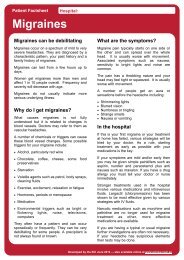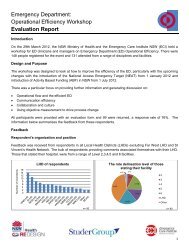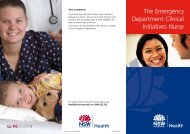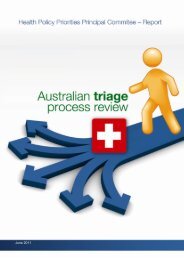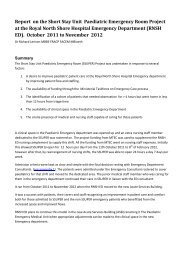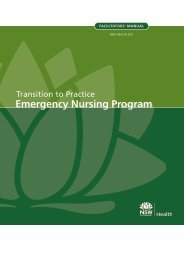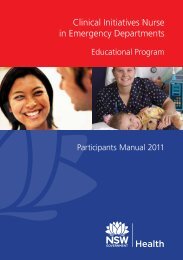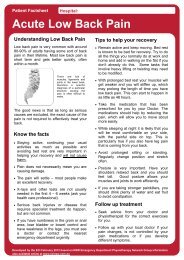Emergency Department Models of Care 2012 - NSW Health
Emergency Department Models of Care 2012 - NSW Health
Emergency Department Models of Care 2012 - NSW Health
- No tags were found...
Create successful ePaper yourself
Turn your PDF publications into a flip-book with our unique Google optimized e-Paper software.
3.2 Clinical Initiatives NurseResuscitation/traumaQuick triage & RegistrationTriageRegistrationClinical Initiatives NurseSub Acute2 hoursFast trackWhat is the model?The Clinical Initiatives Nurse (CIN) is a senior nursing role to manage patients queuing in theED waiting room. The three priorities <strong>of</strong> the CIN role in the emergency department waitingrooms are:1. Review patients within their triage benchmark time to ensure they remain clinically safe2. Provide ongoing communication with the patient3. Initiate diagnostics or treatment with a particular emphasis on managing the patient’s pain(<strong>NSW</strong> Ministry <strong>of</strong> <strong>Health</strong> <strong>2012</strong>). For detailed information about CIN, please refer to http://www.ecinsw.com.au/CINIt should be noted that this model may not be utilised in rural EDs where Registered Nursesin the rural sector may complete the First Line <strong>Emergency</strong> <strong>Care</strong> Course (FLECC). This courseprepares and credentials them as an Advanced Clinical Nurse (ACN) who can provide earlyappropriate management <strong>of</strong> acute and life threatening conditions, and relieve pain anddiscomfort for patients at hospitals where Medical Officers are not immediately available.More information can be found at:http://www.ecinsw.com.au/fleccWhy use the model?To improve the quality <strong>of</strong> care for patients in the waiting room. This includes reassessment <strong>of</strong>waiting room patients, early commencement <strong>of</strong> diagnostics and treatment andcommunication <strong>of</strong> wait times and ED processes.Key principles ■ Maintain a nursing presence in the ED waiting room to facilitate a safe clinicalenvironment■■■Communicate with patients and carers regarding ED processes and provision <strong>of</strong> relevanteducation on their health issuesAssess patients following triage with a view to:- initiate diagnostics or treatment (with a set end point)- escalate care, if required.Refer patients to appropriate services that may be external to the ED, for example aMedical Assessment Unit (MAU).<strong>Models</strong> <strong>of</strong> <strong>Emergency</strong> <strong>Care</strong> <strong>NSW</strong> HEALTH PAGE 15




